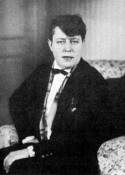
Gurdjieff International Review
Jane Heap
1887–1964
by Rob Baker
They were also "ideal conditions" for the study and teaching of G. I. Gurdjieff's ideas, which once assimilated, became the driving force in Jane Heap's life. Heap and Anderson first heard about Gurdjieff through his American representative A. R. Orage (himself a well-known editor in the literary world in which they moved). After meeting Gurdjieff himself during his 1924 visit to New York, Heap started a Gurdjieff study group in her Greenwich Village apartment. Anderson departed for Gurdjieff's Institute near Paris, accompanied by her new companion, soprano Georgette Leblanc. Heap followed in 1925. She settled in Paris, still helping Anderson edit The Little Review until 1929, when they shut it down. The two continued to visit Gurdjieff periodically at Fontainebleau, drawn to both the man and his ideas. When Anderson wrote of Heap's "uncanny knowledge of the human composition, her unfailing clairvoyance about human motivation," she could just as well have been describing Gurdjieff, as could Ford when he cites the startling originality of Heap's thinking: "She almost never quoted anybody, and what she said she expressed in a personal way. She said nothing she had not thought herself."
Heap had started a Paris Gurdjieff study group in 1927; it blossomed to its fullest in the early 1930's, with the addition of writer Kathryn Hulme and writer/editor Solita Solano. In the fall of 1935, Gurdjieff sent Heap on to London, to work with groups there; her former Paris students approached Gurdjieff shortly after her departure and he took them on as a very special private group who called themselves The Rope.
Heap's London students included such important Work figures as Michael Currier-Briggs, who became her literary executor; clothing designer Elspeth Champcommunal, who was also her companion in later life; ballet teacher Nesta Brooking; Annie Lou Staveley, who was later to found Two Rivers Farm, a Work center in Oregon in the United States; and stage and film director Peter Brook.
Though she had written regularly for The Little Review, mostly pithy, somewhat sardonic criticisms of literature and art, Heap never in her lifetime published an account of her memories of working with Gurdjieff or leading groups in the study of his ideas (both Hulme and Anderson did so, greatly assisted by the editorial skills—and sharp memory—of Solano). After Heap's death in 1964, former students put together a collection of her aphorisms (some her own, some her teacher's) and, in 1983, some notes reflecting her expression of some of the key Gurdjieff ideas. Both the aphorisms and notebooks were once available in limited editions—the former from Phene Press in England and the latter from Two Rivers Press in Oregon. Two Rivers has since issued The Notes of Jane Heap. Here are a few samples from the Phene Press edition:
In an out-of-print publication titled Jane Heap 1887–1964 As Remembered by Some of Those She Taught published by Two Rivers Press in 1988, Nesta Brooking recalls Heap's extraordinary presence at the group's special Work-day celebrations:
It was chiefly through the recurring festivals that we learnt something of the meaning and presentation of food. Such richness we had never experienced, and through the octave the preparations continued towards Christmas, Easter, Whitsun, and others. The difficulty of buying enough of unusual and rationed goods [during World War II] for dishes from far-off countries with their unique and pungent aromas and often colorful elaborations, was always overcome one way or another. Here was an opportunity for those permitted to assist in that venture…During this pre-Paris period [before any of the group members had gone to Paris to meet Mr. Gurdjieff, after World War II], much alteration and decoration took place in Jane's house, and here the insistence upon the combination of practical logic and stability, and upon the aesthetic side in appearance, was a continual reminder. Jane's sure color-sense, practical but always inspiring with that unusual magic touch, was eye-opening. One learnt of the different tempos demanded by the care of tools, different paint and materials, and the laws behind color-mixing, all bringing to light our own ignorance and lack of depth in study. In spite of that "all-that-falls-from-the-wagon-is-lost" baffling our ears, we could but begin again. And again.
So, this woman, this Jane Heap, who was once arrested and fingerprinted for printing chapters from James Joyce's Ulysses and who later held her own in wiseacrings about modern art with Gertrude Stein and her circle—this Jane Heap who finally proclaimed that "art today is not a very important or adult concern… It is interesting only as a pronounced symptom of an aimless society"—this plain Jane from Kansas who sometimes accompanied her father on rounds in the asylum ended up having a very classy sense of real art, real mentation, and real work, and like her own wise and cagey mentor, she was able to pass that impression on to her spiritual heirs.
[Rob Baker was a former co-editor of Parabola Magazine. He wrote frequently on the arts for such publications as DanceMagazine, The Chicago Tribune, The Soho Weekly News, and The New York Daily News. He is the author of The Art of AIDS: From Stigma to Conscience.]
|
Copyright © 1998 Rob Baker Photo © Berenice Abbott This webpage © 1998 Gurdjieff Electronic Publishing Featured: Winter 1997/1998 Issue, Vol. I (2) Revision: November 1, 2002 |